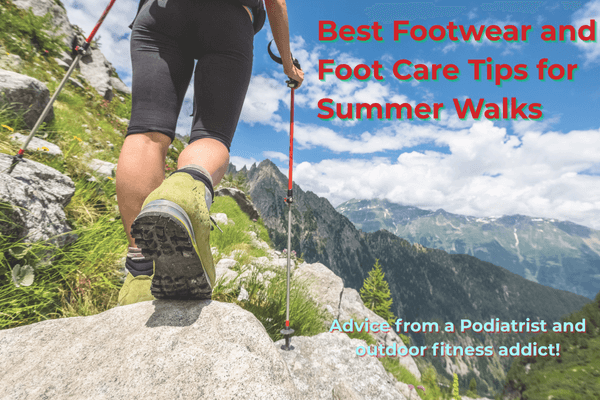Best Footwear and Foot Care Tips for Summer Walks

A walker on a mountain path in summer
Best Footwear and Foot Care Tips for Summer Walks
Advice from a Podiatrist and outdoor fitness addict!
Summer is a wonderful time to explore footpaths, hills, and countryside trails—but to walk comfortably and avoid injury, choosing the right footwear is essential. Whether you are setting off on a weekend ramble, a hillwalking expedition, or a long-distance backpacking route, your shoes or boots play a vital role in supporting your feet and enhancing your walking experience.
As a podiatrist and outdoor fitness specialist, I often see the consequences of ill-fitting or unsuitable footwear: blisters, joint pain, tendon injuries, and toenail trauma are just some of the issues that can develop. The good news is that many of these can be avoided by understanding the demands placed on the foot during walking and choosing the right footwear accordingly.
The Foot in Motion: A Biomechanical Perspective
Walking is a dynamic activity that places complex demands on the foot. With each step, the foot moves through a cycle of heel strike, midfoot loading, and forefoot propulsion. This requires flexibility, shock absorption, and stability. The arch of the foot acts like a spring, compressing and recoiling to store and release energy. During long walks, particularly on uneven or steep terrain, the muscles and tendons of the foot and lower leg work hard to stabilise and propel the body forward.
Shoes or boots that fail to support this natural movement can disrupt gait mechanics and increase the risk of discomfort or injury.
Fit First: Why Shoe Fit Matters
The most important feature of any walking footwear is fit. A well-fitting shoe or boot should feel secure but not tight, allowing for some movement without friction. Your feet naturally expand during long walks, especially in warm weather, so it is important to allow enough space in the toe box to accommodate this.
Top tips for getting the right fit:
- Try shoes on at the end of the day when your feet are at their largest.
- Wear the socks you intend to use when walking.
- Ensure there is a thumb’s width between your longest toe and the end of the shoe.
- Check heel fit—your heel should feel secure, with minimal slipping.
- Walk uphill and downhill in the footwear if possible to test for pressure on the toes.
Walking Shoes vs Walking Boots: Which Should You Choose?
Walking shoes tend to be lighter, more flexible, and well-suited to low-level trails, dry weather, and established paths. They allow greater freedom of movement and are ideal for day walks or summer rambles.
Walking boots, on the other hand, provide more ankle support and protection, especially on uneven, rocky, or wet ground. They are better suited to hillwalking, multi-day treks, or routes involving steep descents or variable weather.
| Feature | Walking Shoes | Walking Boots |
| Weight | Lighter, less tiring over short distances | Heavier, more robust for demanding terrain |
| Flexibility | More flexible for natural movement | Stiffer for greater support |
| Ankle Support | Minimal | Moderate to high |
| Terrain Suitability | Lowland, dry, well-trodden paths | Upland, wet, rocky, or steep terrain |
| Breathability | Often better in hot conditions | May be warmer but more protective |
Ultimately, the choice depends on your intended activity and personal preference. Some walkers even switch between shoes and boots depending on the day’s route.
Lacing and Adjustment: A Small Detail That Makes a Big Difference
Lacing is often overlooked, but proper adjustment helps to prevent foot slippage and blisters. You can modify lacing techniques to relieve pressure points or secure the heel more firmly. Techniques such as the “heel lock” or “surgeon’s knot” are particularly useful for longer walks or downhill sections.
Preventing Blisters and Promoting Comfort
Blisters are one of the most common problems faced by walkers, particularly in hot weather. They occur when friction, moisture, and heat cause layers of skin to separate. Once formed, they can make every step painful.
To reduce the risk of blisters:
- Ensure shoes or boots are properly broken in before a long walk.
- Choose moisture-wicking socks—merino wool or technical blends work well.
- Keep feet dry; consider using a foot powder or applying a barrier balm to areas prone to rubbing.
- Carry blister plasters or tape as part of your kit.
Comfort should never be sacrificed for style or cost. A good shoe or boot should feel supportive, cushioned, and stable. If it does not feel right in the shop, it is unlikely to improve on the trail.
Final Thoughts
The right walking footwear can enhance your outdoor experience, helping you walk further and more comfortably with fewer problems. Think carefully about the type of walking you enjoy, the terrain you are likely to encounter, and the specific needs of your feet.
If you are unsure about your foot type or have a history of foot or ankle discomfort, a podiatry assessment or Gait Analysis can be a helpful step before investing in new footwear.

 Active Podiatry - Podiatry in Kent for Runners & Active People
Active Podiatry - Podiatry in Kent for Runners & Active People